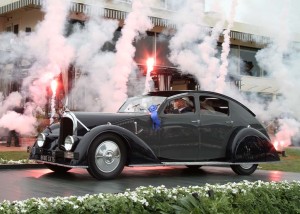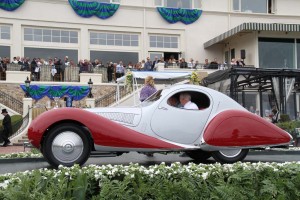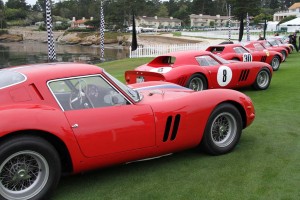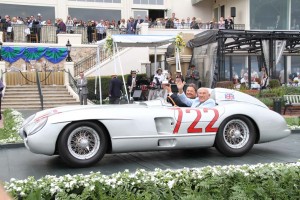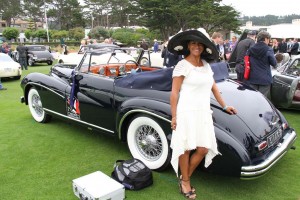Parked on the lawn, the motor of his 1934 Avian Voisin C-25 Aerodyne idling, Peter Mullin had no idea what to expect. The next couple minutes might bring the biggest surprise of his life or the biggest disappointment.
There was no question he’d delivered a showstopper with the French sedan he’d entered into the annual Pebble Beach Concours d’Elegance. It took a full three years to restore the Voisin – “And I had already been planning it for seven years,” he recalled. But there were two other striking examples of pre-war automotive elegance sitting alongside, anyone of which might grab the most coveted trophy in the world of classic cars.
Suddenly, like angels calling, the trumpets began their fanfare, fireworks bursting into the air as Mullin got the signal he was hoping for. Yet it wasn’t until he had the Aerodyne parked on the center stage that the long-time collector finally allowed the reality to set in. After 30 years of trying, he had just won the Concours’ Best-in-Show.
“I just can’t believe it,” Mullins repeated, still in shock, confetti now covering the dark grey and black Voisin, which was one of only six C-25s built by French aeronautical pioneer Gabriel Voisin after he decided to switch to automotive manufacturing in the wake of World War I. “I thought I’d finished third. This is the most rewarding thing that ever happened to me in the car world,” said Mullin.
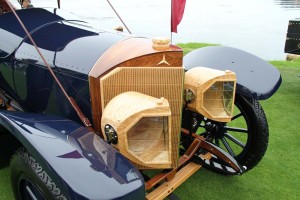
The second body for a 1915 Mercedes has its own custom platform, including hand-tooled wooden "headlights." The bodies can be swapped in four hours.
Of course, the decision by the Pebble Beach judges left the owners of 226 other classic cars struggling with their disappointment. Not the fans, however. As always, the event delivered the sort of peek into the world of automotive elegance that can be found nowhere else.
Now in its 61st year, has become more and more open to experimentation, in recent years, reaching beyond the tradition al Bugattis, Duesenbergs and Talbot Lagos to put on display hot rods, campers and, this year, an assortment of unusual motorcycles including a rare Ferrari bike.
But the focus is still skewed towards the era between the two World Wars which, to many, saw some of the most grand examples of automotive design.
That meant a fairly consistent crowd gathering around Hugo Modderman’s 1934 Delahaye Atlas, believed to be just one of four surviving. The Dutch collector, now based in Monaco, has been coming to the 19th green at Pebble Beach for the last decade, though this was only the second time he has exhibited – a nonetheless impressive feat considering it required him to ship his car from Rotterdam to the U.S. before driving it to the Monterey Peninsula.
“The Concours has great people seeing great cars,” he said, explaining his decision to go to so much trouble, “the best cars in the world.”
It’s not unusual for the cars on display at the Concours to undergo meticulous restoration efforts – like Mullin’s Voisin – that can take years and cost millions of dollars. That may seem excessive but bringing back to life an 80-year-old automobile that may have been one of only a handful handmade isn’t quite the same as replacing the seat covers and carpet mats on a mass-produced model from the ‘70s.
Mullins, for example, had to have a custom loom set up to re-weave the extraordinary art deco fabric in the C-25 Aerodyne.
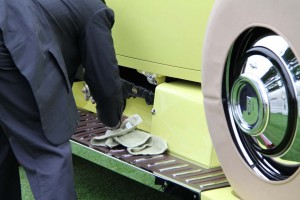
Owners become almost neurotic when it comes to ensuring everything is right before a car gets judged.
The typical major restoration process for a car of Pebble Beach quality begins by taking “1000s of pictures and labeling everything before you fit all the parts into bags,” explains Kyle Osborne, of Tired Iron Works, in Monrovia, California, which handled the work on a 1938 Fiat 6C-2300 Superleggera on display at the Concours. “Those pictures are key to remembering how everything goes back together.”
Has he ever had a few small parts left over? Yes, Osborne admits, though not on the Superleggera.
Extensive research is also critical. In the world of such exclusive automobiles, it would be considered a sin to restore a car by chroming parts that were originally produced in a nickel finish. It would also cost you points when the judges come around.
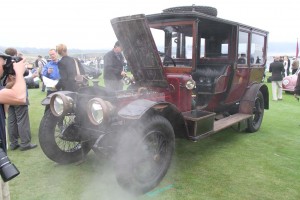
A limousine once owned by Britain's King George V puts out a smoke screen as its engine is fired up.
“The cars need to be judged according to the level the first owner would have expected,” explained Gordon Apker, one of the chief judges at Pebble Beach.
Other factors include the quality of the restoration, with even the smallest details, such as a pin-sized blemish in the paint finish, enough to earn some demerits – though officials insist they don’t take points away for finding blades of grass stuck in a car’s tires. Nonetheless, nervous owners can readily be found polishing and tweaking until the last possible moment when their efforts are assessed.
It doesn’t hurt to have something truly unique, and many of the winners, over the Concours’ 61 years, have been cars long thought to have vanished. While it didn’t wind up with the blue ribbon, one of the more unusual entries in the 2011 Pebble Beach Concours was a 1915 Mercedes-Benz 2860 built for the mayor of Ulm, Germany.
The car was originally conceived as a sport touring sedan but the mayor decided he also wanted something for colder weather and, “in those days, you would order a second body for winter,” noted owner Charles Bronson. The striking 1915 Mercedes may not have won this year’s Concours but it did achieve something of a record, the first car ever shown at the event to require two spaces.
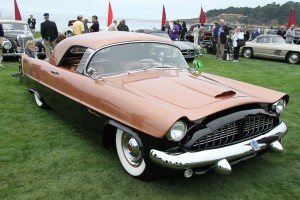
One of four 1952 Packard Panther show cars built of fiberglass, this one heavily modified by the maker two years later.
Bronson acquired both bodies, having a wooden chassis custom-built to store the spare when not in use. There are elegantly burled wooden “headlights,” and lifting the engine cover reveals a tool chest containing everything needed to swap the bodies – a process that he said would take about four hours.
While collectors typically vie to wrangle an invitation to Pebble Beach, organizers often have to go hunting for the cars they truly hope to have on display. Nowhere was that more apparent than in the collection of 26 Ferrari GTOs, the bulk of just 36 ever built. Each is today estimated to be worth at least $25 million – though one of the ones on display was found being used by a Texas high school shop class before going through its restoration.
Is it worth the effort to get a car ready? That is a matter of debate, though for those who have the passion – and the money – it’s clearly justified. All the more so, say those in the know, for a car that wins at Pebble. Any trophy will add significantly to a car’s prestige and value, and the Best-in-Show for Mullin’s Voisin instantly added millions to its price tag – if he ever decides to sell it.

